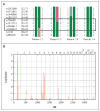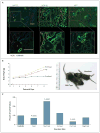Epilepsy, ataxia, sensorineural deafness, tubulopathy, and KCNJ10 mutations
- PMID: 19420365
- PMCID: PMC3398803
- DOI: 10.1056/NEJMoa0810276
Epilepsy, ataxia, sensorineural deafness, tubulopathy, and KCNJ10 mutations
Abstract
Background: Five children from two consanguineous families presented with epilepsy beginning in infancy and severe ataxia, moderate sensorineural deafness, and a renal salt-losing tubulopathy with normotensive hypokalemic metabolic alkalosis. We investigated the genetic basis of this autosomal recessive disease, which we call the EAST syndrome (the presence of epilepsy, ataxia, sensorineural deafness, and tubulopathy).
Methods: Whole-genome linkage analysis was performed in the four affected children in one of the families. Newly identified mutations in a potassium-channel gene were evaluated with the use of a heterologous expression system. Protein expression and function were further investigated in genetically modified mice.
Results: Linkage analysis identified a single significant locus on chromosome 1q23.2 with a lod score of 4.98. This region contained the KCNJ10 gene, which encodes a potassium channel expressed in the brain, inner ear, and kidney. Sequencing of this candidate gene revealed homozygous missense mutations in affected persons in both families. These mutations, when expressed heterologously in xenopus oocytes, caused significant and specific decreases in potassium currents. Mice with Kcnj10 deletions became dehydrated, with definitive evidence of renal salt wasting.
Conclusions: Mutations in KCNJ10 cause a specific disorder, consisting of epilepsy, ataxia, sensorineural deafness, and tubulopathy. Our findings indicate that KCNJ10 plays a major role in renal salt handling and, hence, possibly also in blood-pressure maintenance and its regulation.
2009 Massachusetts Medical Society
Conflict of interest statement
Dr. Sheridan reports receiving grant support from the Well-being of Women. No other potential conflict of interest relevant to this article was reported.
Figures




Comment in
-
Membrane physiology--bridging the gap between medical disciplines.N Engl J Med. 2009 May 7;360(19):2012-4. doi: 10.1056/NEJMe0901812. N Engl J Med. 2009. PMID: 19420371 No abstract available.
-
The EAST syndrome and KCNJ10 mutations.N Engl J Med. 2009 Aug 6;361(6):630; author reply 630-1. doi: 10.1056/NEJMc091202. N Engl J Med. 2009. PMID: 19657131 No abstract available.
-
A K+ channel that channels neurology to nephrology.Clin Genet. 2010 Mar;77(3):230-1. doi: 10.1111/j.1399-0004.2009.01322.x. Epub 2009 Nov 23. Clin Genet. 2010. PMID: 19968668 No abstract available.
References
-
- Kleta R, Bockenhauer D. Bartter syndromes and other salt-losing tubulopathies. Nephron Physiol. 2006;104:p73–p80. - PubMed
-
- Simon DB, Nelson-Williams C, Bia MJ, et al. Gitelman’s variant of Bartter’s syndrome, inherited hypokalaemic alkalosis, is caused by mutations in the thiazide-sensitive Na-Cl cotransporter. Nat Genet. 1996;12:24–30. - PubMed
-
- Simon DB, Karet FE, Hamdan JM, DiPietro A, Sanjad SA, Lifton RP. Bartter’s syndrome, hypokalaemic alkalosis with hypercalciuria, is caused by mutations in the Na-K-2Cl cotransporter NKCC2. Nat Genet. 1996;13:183–8. - PubMed
-
- Simon DB, Karet FE, Rodriguez-Soriano J, et al. Genetic heterogeneity of Bartter’s syndrome revealed by mutations in the K+ channel, ROMK. Nat Genet. 1996;14:152–6. - PubMed
-
- Simon DB, Bindra RS, Mansfield TA, et al. Mutations in the chloride channel gene, CLCNKB, cause Bartter’s syndrome type III. Nat Genet. 1997;17:171–8. - PubMed
Publication types
MeSH terms
Substances
Grants and funding
LinkOut - more resources
Full Text Sources
Other Literature Sources
Medical
Molecular Biology Databases
Miscellaneous
